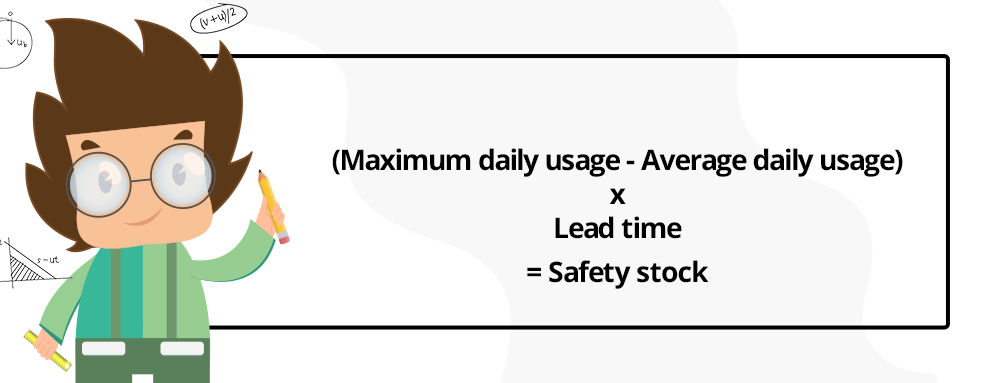What Is a Safety Stock Management and How to Calculate It
Inventory Management
LAST UPDATE: OCT 10, 2022
11 minutes reading
You maintain the supplies required to run your firm in a facility or warehouse. It serves as a storage area for tools, abrasives, adhesives, and sealants. Think about one of those necessities for your creations or constructions running out. Waiting until you can find the required inventory may cause your firm to stall.
Safety stock is designed to solve this issue. However, safety stock won’t be enough to fully benefit your company. For production to continue, inventory management must be effective.
What Is Safety Stock?
Cycle stocks, or inventory that is anticipated to be sold within a certain time frame, and safety stock meaning are typically the two components of stock inventory. As a buffer, safety stock takes into account potential uncertainties like:
- Excess demand
- Supplier delays
- Inaccurate demand or inventory forecasts
- Failure to place timely reorders
- Financial constraints
Safety stock mitigates the risks and effects of stockouts, enabling your supply chain to continue operating normally even after cycle stock is exhausted.
Is Safety Stock Considered Inventory?
Yes, because the buffer that safety stock offers is essential for efficient inventory management. Effective inventory control goes beyond simply keeping track of current stock levels, taking into account past, present, and future market situations, and accounting for supply lead times.
Cycle stock and safety stock must be coordinated for effective inventory management to keep inventory levels in accordance with supply and demand. This makes inventory management easier and more reliable.
What Is the Difference Between Safety Stock and Buffer Stock?
What do these terms actually mean? You may have run upon them at some point in your business. We’ll delve deeper into these subjects today in the hopes that you’ll gain some knowledge that will make it easier for you to use your inventory management systems.
There isn’t much of a semantic distinction between safety stock and buffer stock; they are merely synonyms for one another.
What is Buffer Stock?
The excess product kept on hand as buffer stock is the kind that is used when there are unexpected delays from suppliers or when demand is higher than planned. When there is volatility in demand, supply, and your supply chain, buffer stock is always kept on hand to make sure you can meet consumer demand and avoid an out-of-stock issue.
Benefits of Keeping Buffer Stock
Utilizing buffer stock in your company is mostly done to prevent out-of-stock situations. Stockouts obviously have a negative effect on your business; in addition to representing lost direct sales and money, they also have an influence on your restock restrictions and your Inventory Performance Index Score.
Essentials of a Safety Stock
For setting your safety stock quantities, some important factors to consider are:
- Having precise demand and supply estimates can aid in volume estimation.
- To transfer stock from your 3PL, you must be aware of the replenishment frequency needed.
- factoring in the production and delivery lead periods of suppliers.
- Perishability of the products in terms of their shelf life
- Maintaining safety stock also needs to take seasonal fluctuations into account.
What Are the Benefits of Having Safety Stocks?
Running out of stock is made easier by having safety stock. If you have enough safety stock on hand, you won’t need to rely on your suppliers’ prompt deliveries or turn away clients because of low stock levels. Up until your next shipment of ordered stock arrives, you are covered by safety stock. Let’s examine the value of safety stock for your company:
Also check our past blog about Negative Inventory: Restore your Stock Back into a Positive State
Protection Against Demand Peaks
Your safety stock shields you from demand spikes that occur suddenly and incorrect market predictions that can occur during a busy or festive season.
It acts as a buffer when the items you ordered arrive at your warehouse later than you anticipated.
It makes sure your business doesn’t run out of in-demand products and enables you to constantly fulfill requests.
Stock Up to Prepare for Lengthier Lead Times
Even if your supplier consistently makes on-time deliveries and you have never experienced a supply lag, this might not always be the case. Your products may get to you later than anticipated due to unanticipated production or shipment delays, such as a bottleneck at your supplier’s end or a delivery delay brought on by bad weather. In these circumstances, safety stock serves as your buffer against a potential stockout scenario and aids in order fulfillment while you wait for your requested stock to arrive.
Mitigation Of Price Fluctuations
The price of your goods may increase unexpectedly due to market changes. This could be brought on by a sudden shortage of raw resources, a rise in the price of raw materials, unanticipated market demand spikes, new rivals, or new government regulations. It can assist you to avoid the expenditures of buying the stock at higher prices without sacrificing sales if you have enough backup stock during these unforeseen events.
How To Calculate Safety Stock
Knowing how much safety stock to keep is necessary to reap the benefits of doing so. This is because too little safety stock results in lost sales and too much safety stock might result in increased holding expenses. You can determine the ideal quality of safety stock for your company by using a formula.
Every safety stock calculation method has a slightly different set of inputs, but they all depend on your knowledge of your lead time, which is the interval between the start of an order and the end of the delivery procedure.
There Are a Number of Different Methods to Calculate Safety Stock:
- Fixed safety stock
- Time-based calculation
- The general formula
- Heizer Render formula
- Greasley method
Fixed Safety Stock
Production planners used the fixed safety stock technique. Without following a specific method, they decided how much safety stock to hold from the maximum daily usage for a certain amount of time.
In most cases, the figure for fixed safety stock doesn’t vary until the production planner decides to do so.
You can even set fixed safety stock levels to zero for products you want to phase out. However, you might not be able to fill the orders if there is an unexpected increase in demand for a product for which there very little safety stock.
Time-Based Calculation
With this method, safety stock levels are computed over a specific time frame depending on the product’s future estimate. This approach combines anticipated demand based on statistical techniques with actual demand derived from sales orders.
Using this strategy has a risk that you can end up carrying too much unnecessary stock if your products are moving slower than anticipated because it cannot predict business risks.
The General Formula
The easiest and most popular way to determine safety stock is with this formula. The average safety stock that the corporation should maintain in the event of a stockout is calculated, but the seasonal variations in demand are not taken into account.
Maximum daily usage, which is the highest number of units sold in a single day, is multiplied by the maximum lead time, which is the lengthiest period of time the vendor has had to deliver the stock, and safety stock is calculated by deducting the product of average daily usage, which is the average number of units sold per day, and average lead time (which is the average time taken by the vendor to deliver the stock).
Heizer & Render formula
When your vendor’s supply varies significantly, Heizer & Render’s formula works well. It makes use of the lead time distribution’s standard deviation to provide you a more realistic picture of your lead time and the frequency of really late shipments. However, it doesn’t account for variations in demand.
Your desired service factor (Z score) is multiplied by the standard deviation in lead time (dLT), which represents the amount and frequency by which the average lead time deviates from the actual lead time.
You can choose how certain you want to be that you have enough stock using the Z score, also known as the desired service factor. It is a value that you choose in order to avoid a stockout situation. A lower score increases the likelihood that you may run out of stock. For instance, there is a 99% chance that you won’t experience a stockout if you choose a Z score of 2.33.
Greasley Formula
Greasley’s formula gives a more precise method of determining safety stock because it takes lead time and demand fluctuations into consideration. However, it ignores inventory that is still being produced and isn’t yet ready for sale.
Using Greasley’s method, safety stock is derived by multiplying average demand (Davg), the intended service factor (Z score), and the standard deviation in lead time (LT). Average demand is the total quantity of material required each day over a given period.
What Is the Safety Stock Formula?
The following is the safety stock formula:
According to constraint analysis, in a manufacturing setting the only safety stock that matters is the inventory buffer located directly in front of the bottleneck operation. This buffer needs to be sufficiently large to ensure that any changes in the production process upstream from the bottleneck operation do not interfere with the bottleneck. If there are persistent issues with the upstream production process, this may necessitate a sizeable safety stock.
Common Safety Stock Challenges & Risks
Though useful in preventing stockouts, safety stock can also have significant drawbacks. When creating safety stock methods, inventory managers need to take a few things into account.
1- Zeroing Out the Safety Stock
Setting the safety stock to zero is a common strategy used by supply chain managers to reduce the expenses associated with keeping too much inventory on hand. This is particularly frequent when a sudden increase in demand levels out and returns to normal. The problem of having too much inventory is resolved, but the risk of not having a buffer to manage future changes in demand or supplier delays, which can be even more expensive, is re-ignited.
2- Static Safety Stock
Since safety stock doesn’t expand along with the firm, when the enterprise grows, the number of units designated as safety stock may not be sufficient. Inventory managers should periodically analyze bottlenecks and safety stock levels and make any required adjustments.
3- A Surplus of Safety Stock
Although carrying safety stock is frequently important to prevent sales losses due to stockouts, there is no getting around the fact that it decreases the company’s available cash. Lack of space for current cycle stock or new items can result from having too much safety stock.
Additionally, it is a sizable corporate expense because holding fees frequently account for 20% or more of the overall cost of the inventory. The additional sums that must be acquired, as well as the increased costs of storage and labor, account for a large portion of this expense.
4- Formulas for Standard Safety Stocks
When there are many unknowable variables, the typical safety stock formula may not apply to all sectors or operating methods. To provide the most accurate figures, these formulas should be modified to suit particular businesses and circumstances.
5- Allowing Safety Stock to Fall
Supply chain managers may be tempted to reduce safety stock as average lead times go shorter. However, preserving enough safety stock should be a priority because, in addition to long lead times, other variables may contribute to inventory problems.
6- Use of Safety Stocks in Excess
A good defense against stockouts is safety stock, but it is not a panacea for inventory problems.
To balance the dangers and expenses of stockouts with those of having too much stock on hand, supply chain managers must ascertain the ideal quantity of safety stock for each item.
Safety Stock Examples
However, businesses must be careful not to purchase an excessive amount of inventory. Consider a clothing store as an illustration. They won’t be able to sell all the winter coats they purchase if they buy too many. The winter coats will be stored for a full year till the next winter.
The entire sum of money spent on extra coats could have been used to cover operating costs. A buffer stock inventory system has two opposing sides that might be advantageous for the business or detrimental to the health of the business.









Recent Comments